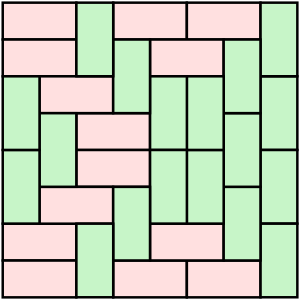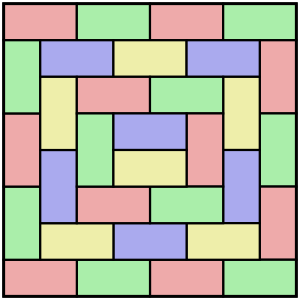Domino tiling facts for kids
In geometry, a domino tiling is a way to completely cover a flat area using only dominoes. Imagine a domino as a shape made of two unit squares joined side-by-side. When you tile a region, you place these dominoes so they cover the entire area without overlapping and without leaving any gaps. It's like solving a puzzle where all the pieces are the same shape!
Contents
Understanding Domino Tilings
To make it easier to understand, think of a grid, like a chessboard. Each square on the grid is a "unit square." A domino covers exactly two of these squares. When we talk about a domino tiling, we're finding a way to place these 1x2 dominoes on a larger shape made of squares, so every square is covered exactly once.
Height Functions: A Chessboard Example
Sometimes, we can give a "height" to the corners of the squares in a domino tiling. Imagine a chessboard. Pick one corner and call its height 0. Now, as you move along the edges of the squares, you can change the height. If the square to your right is black, you add 1 to the height. If it's white, you subtract 1. This creates a pattern of heights across the grid, which can help mathematicians study how tilings work.
Counting How Many Ways to Tile
Have you ever wondered how many different ways you can tile a shape with dominoes? It turns out this can be a very tricky question!
Tiling Rectangles
For a simple rectangle, like a 2xN rectangle (meaning 2 squares wide and N squares long), the number of ways to tile it with dominoes follows a cool pattern. It's related to the Fibonacci sequence! The Fibonacci sequence starts 0, 1, 1, 2, 3, 5, 8, and so on, where each number is the sum of the two before it. So, a 2x1 rectangle has 1 way, a 2x2 has 2 ways, a 2x3 has 3 ways, and a 2x4 has 5 ways.
For larger rectangles, like an 8x8 square, the number of ways to tile it becomes huge! For example, an 8x8 square can be tiled in 12,988,816 different ways! If the rectangle has an odd number of squares (like a 3x3 or 3x5), it's impossible to tile it with dominoes because each domino covers two squares, and an odd number of squares can't be perfectly divided by two.
Aztec Diamonds
Some shapes have very specific numbers of tilings. An Aztec diamond is a special shape that looks like a diamond made of squares.
An Aztec diamond of order n has a very large number of tilings, specifically 2(n + 1)n/2. For example, an Aztec diamond of order 4 has 2(4+1)4/2 = 210 = 1024 tilings! But if you change the shape just a little bit, the number of tilings can drop dramatically.
Tatami Tilings
Tatami are traditional Japanese floor mats. They are shaped like dominoes (1x2 rectangles). People use them to tile rooms, but they have extra rules about how they can be placed.
A common rule is that you should avoid having four tatami mats meet at one corner. Instead, it's considered good luck if only three tatami mats meet at any corner. This makes tiling a room with tatami mats a special kind of domino tiling puzzle!
Images for kids
See also
 In Spanish: Teselado en dominó para niños
In Spanish: Teselado en dominó para niños






